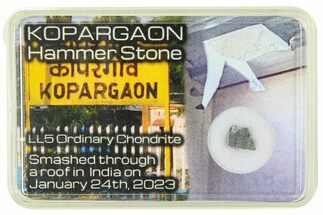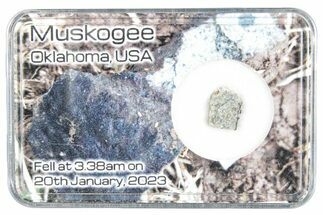.22" Chondrite Meteorite Hammer Stone (0.08 g) - Kopargaon
This is a hammer stone from the LL5 chondrite known as Kopargaon, which fell near the town of the same name in India on the morning of January 24, 2023. It comes in its own labeled display case.
This LL5 chondrite made quite a smashing entrance when it landed in the village of Bhojade Chouki, part of the Kopargaon administrative district in central Maharashtra, India. On January 24, 2023, at just about 7:00AM local time, several eyewitnesses reported sounds of detonations and bright objects falling from the sky. These objects were this chonridte, which smashed through the roof of a house in the village. It shattered on impact and left an impact dent in the bedroom it fell in: quite the wake-up call!
Kopargaon resembles many chondrites, containing brecciated clasts with occasional metal grains, brown limonitic oxidation stains, and chondrules in a light gray matrix. Several fragments retain a dark, dull fusion crust, regmaglypts, and even radiating flow lines as this molten material solidified. About a kilogram of material in total is known.
Kopargaon resembles many chondrites, containing brecciated clasts with occasional metal grains, brown limonitic oxidation stains, and chondrules in a light gray matrix. Several fragments retain a dark, dull fusion crust, regmaglypts, and even radiating flow lines as this molten material solidified. About a kilogram of material in total is known.
Hammer stones are the names given to meteorite fragments that hit man-made objects, animals, or people when they fall. Hammer stones are often identified by the scuffed fusion crusts that can contain traces of paint, rubble, or other materials from the objects they hit. Because they are so rare, they are valued collectors' items. Often the items hammer stones hit go up in value, just be being damaged by a meteorite!
About Chondrites
A chondrite is a stony (non-metallic) meteorite that has not been modified by either melting or differentiation of the parent body. Chondrites are formed when various types of dust and small grains in the early Solar System accreted to form primitive asteroids. Some such bodies are captured in the planet’s gravity well and pulled to the surface. They are by far the most common type of meteorite, representing about 86 percent of all meteorites that have fallen to Earth.
Prominent among the components present in chondrites are the enigmatic chondrules, millimeter-sized spherical objects that originated as freely floating, molten or partially molten droplets in space; most chondrules are rich in the silicate minerals olivine and pyroxene. Chondrites also contain particles of various metals such as nickel, iron, and aluminum. These formed at the very beginning of the solar system and aggregated over time: they are the oldest rocks known on Earth!
Chondrites are divided into about fifteen distinct groups on the basis of their mineralogy, bulk chemical composition, and oxygen isotope compositions. The various chondrite groups likely originated on separate asteroids or groups of related asteroids. Each chondrite group has a distinctive mixture of chondrules, refractory inclusions, matrix (dust), characteristic chondrule sizes, and other components. Other ways of classifying chondrites include weathering and shock. The L chondrite group is the most common of these.
A chondrite is a stony (non-metallic) meteorite that has not been modified by either melting or differentiation of the parent body. Chondrites are formed when various types of dust and small grains in the early Solar System accreted to form primitive asteroids. Some such bodies are captured in the planet’s gravity well and pulled to the surface. They are by far the most common type of meteorite, representing about 86 percent of all meteorites that have fallen to Earth.
Prominent among the components present in chondrites are the enigmatic chondrules, millimeter-sized spherical objects that originated as freely floating, molten or partially molten droplets in space; most chondrules are rich in the silicate minerals olivine and pyroxene. Chondrites also contain particles of various metals such as nickel, iron, and aluminum. These formed at the very beginning of the solar system and aggregated over time: they are the oldest rocks known on Earth!
Chondrites are divided into about fifteen distinct groups on the basis of their mineralogy, bulk chemical composition, and oxygen isotope compositions. The various chondrite groups likely originated on separate asteroids or groups of related asteroids. Each chondrite group has a distinctive mixture of chondrules, refractory inclusions, matrix (dust), characteristic chondrule sizes, and other components. Other ways of classifying chondrites include weathering and shock. The L chondrite group is the most common of these.
TYPE
Ordinary Chondrite (LL5)
LOCATION
Bhojade Chouki, Kopargaon taluka, Ahmednagar district, Maharashtra, India
SIZE
.22" wide, Weight: 0.08 grams
CATEGORY
ITEM
#286033
 Reviews
Reviews









